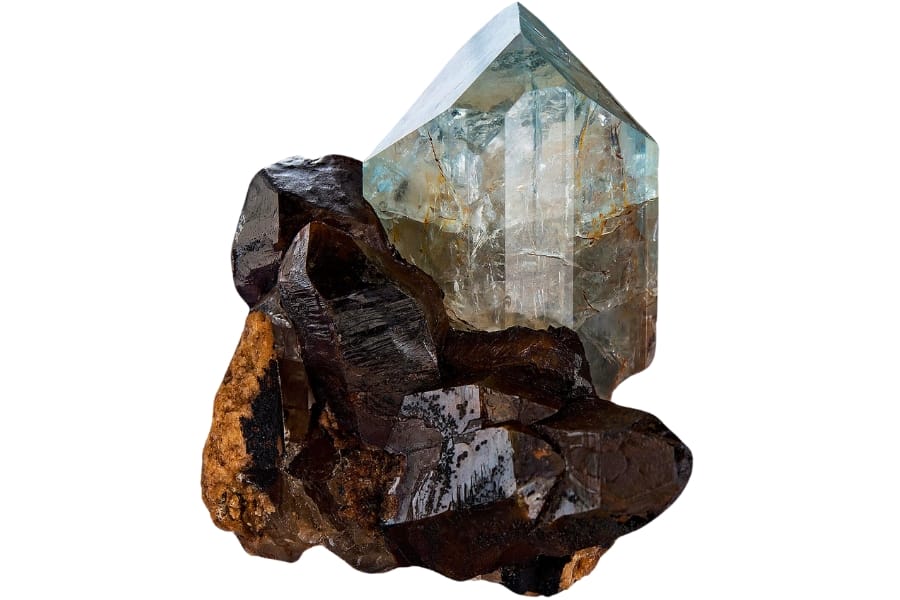Utah is renowned for its breathtaking landscapes, but did you know it also boasts an extraordinary array of rocks, gems, and crystals? Its geological treasure trove ranges from the vibrant red sandstones of Zion National Park to the shimmering topaz found in the Thomas Range.
The variety of rocks and minerals found in Utah is not just broad but also visually stunning. If you’re wondering about the most common natural treasures that you can uncover here, you’re in for a treat!
We’ll introduce you to the rocks, gemstones, and crystals of Utah and show you why each one is special. We’ll also point you to the places where you can find them so you’ll be ready on your quest to explore our state for these wonders. Let’s begin!
A List of The Common Rocks, Stones, and Minerals Found in Utah
Utah is nothing short of amazing, especially if we’re talking about its geological wonders. Sculpted over a millenia, our state’s landscapes hides different types of rocks.
We’ve created simple, useful guides that will help you successfully explore Utah for its rocks, stones and minerals:
Utah Rocks, Minerals, and Gems
Before we delve into the common finds here, let’s first get to know our state’s official rock, mineral, and gem:
| Utah State Rock | Coal |
| Utah State Mineral | Copper |
| Utah State Gem | Topaz |
If you have plans of visiting our state and the different rockhounding sites here, make sure to abide by our local collecting guidelines. This way, we can make sure that our activity remains sustainable for the next generations to also enjoy.
You may check with the Bureau of Land Management Utah for more information on the rules and regulations of the area that you want to visit and search through.
Always Confirm Access and Collection Rules!
Before heading out to any of the locations on our list you need to confirm access requirements and collection rules for both public and private locations directly with the location. We haven’t personally verified every location and the access requirements and collection rules often change without notice.
Many of the locations we mention will not allow collecting but are still great places for those who love to find beautiful rocks and minerals in the wild without keeping them. We also can’t guarantee you will find anything in these locations since they are constantly changing.
Always get updated information directly from the source ahead of time to ensure responsible rockhounding. If you want even more current options it’s always a good idea to contact local rock and mineral clubs and groups
Copper

Copper is a shiny, reddish-brown metal that’s been used for thousands of years. It’s often found mixed with other minerals.
It forms deep inside the Earth, where hot fluids carry the copper up towards the surface. These fluids cool down as they get closer to the crust, and that’s when copper starts to form, often alongside other minerals like quartz or iron.
One of the reasons for its value is because it’s super useful. It’s an excellent conductor of electricity, that’s why it’s used in wires and cables.
Copper is also very flexible and can be stretched into thin wires without breaking. Plus, it doesn’t rust easily, so things made of copper last a long time.
Because it’s so useful in our daily lives, from electrical wiring to making coins, copper remains a highly sought-after metal.
Where you can find copper in Utah
As Utah’s official state mineral, there are a handful of places where you can find it within the state, such as:
- Lucin Mining District
- Strawberry Mine
- East Tintic Mountains
Coal

Coal is a black or brownish-black rock that we use for energy. It has played a big role in the history of human development, helping power the Industrial Revolution.
This rock comes from plants that lived in swamps millions of years ago. When they died, they fell into the water and got buried under mud and other dead plants. Over time, more and more layers piled on top, squishing everything underneath.
As the layers build up, they press down on the dead plants, squeezing out water and making the material denser and denser. The pressure and heat change these dead plants into coal.
We value this rock because it’s a great source of energy. When you burn coal, it releases a lot of heat that can be used to make electricity, which powers our homes and gadgets.
It can also be used in factories to make things like steel. Even though there are cleaner sources of energy out there, coal is still used because it’s abundant and relatively cheap to get.
Where you can find coal in Utah
Like copper, you can also uncover coal in many places in our state. Some of these locations are:
- Beaver Creek Mine
- Henry Mountains
- Coaly Basin
Galena
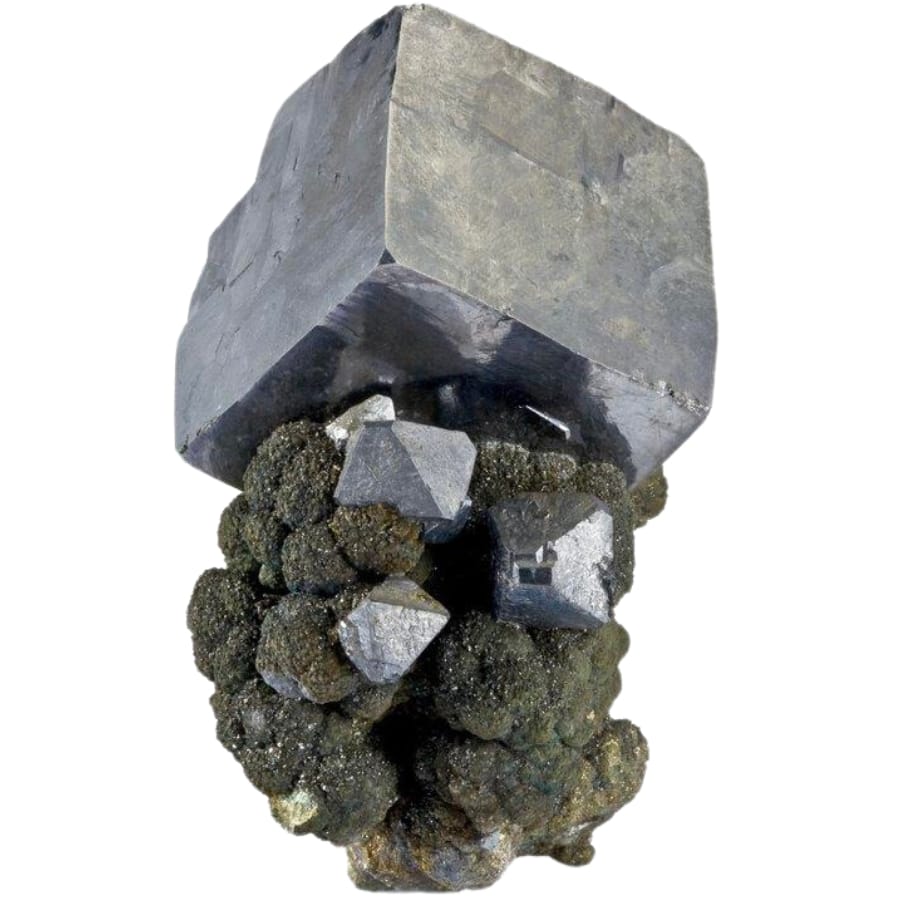
Galena is a mineral that looks like shiny, metallic cubes. It’s usually a silvery-gray color and is really heavy for its size. It’s the main source of lead, a metal we use in many things.
This mineral forms deep underground in places where hot, mineral-rich fluids move through rocks. When they cool down, the elements start to stick together and form crystals. In galena’s case, sulfur and lead from these fluids combine to create it.
For thousands of years, we have valued galena mostly because it’s the main way we get lead. In ancient times, lead from galena was used to make pipes and paint, although now we know that lead can be harmful if we’re not careful with it.
Today, we use lead in batteries, like the kind in cars, and in protective shields for X-ray machines in hospitals because it’s really good at blocking radiation.
Another neat thing about galena is that it sometimes has silver in it, which makes it even more valuable.
Where you can find galena in Utah
If you’re eyeing for galena, you can explore the following specific sites:
- Raft River Mountains
- Logan Canyon
- Bear River Range
Limonite
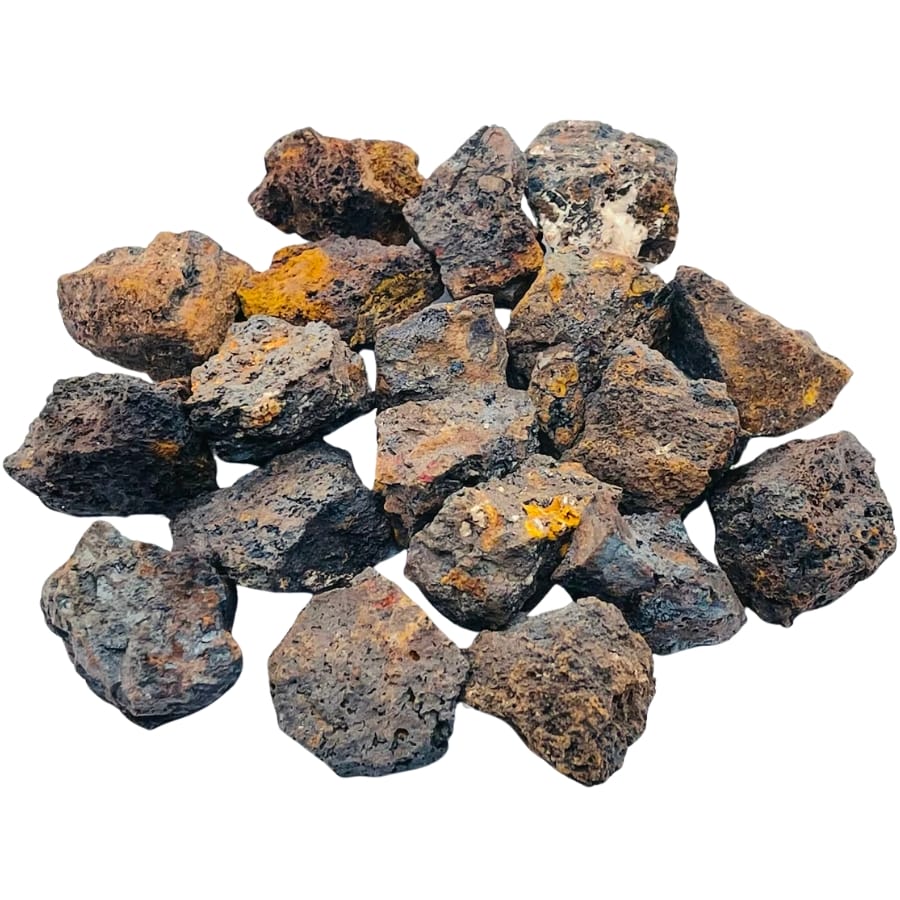
Limonite is not just one substance, but a mix of several iron-containing minerals. It’s usually brownish or yellowish, and it kind of looks like rust. That’s because it often forms when iron and oxygen mix with water.
Most of the time, this mineral forms in places where there used to be water, like old lakes or swamps. Over a long time, as iron in the soil or rocks reacts with the oxygen in the water, limonite starts to form.
It’s kind of like a slow, natural process of making rust. Sometimes, limonite is found in the form of small, round pebbles called “oolites“.
Limonite is a source of iron, which is super important for making steel, which is used in everything from buildings to cars. This mineral is also used in pigments. Some artists even prefer using limonite for its natural, earthy tones.
Where you can find limonite in Utah
Among the many places you can find limonite in Utah are the following:
- Carbonate Gem Mines
- Antelope Island
- Courthouse Wash
Brochantite
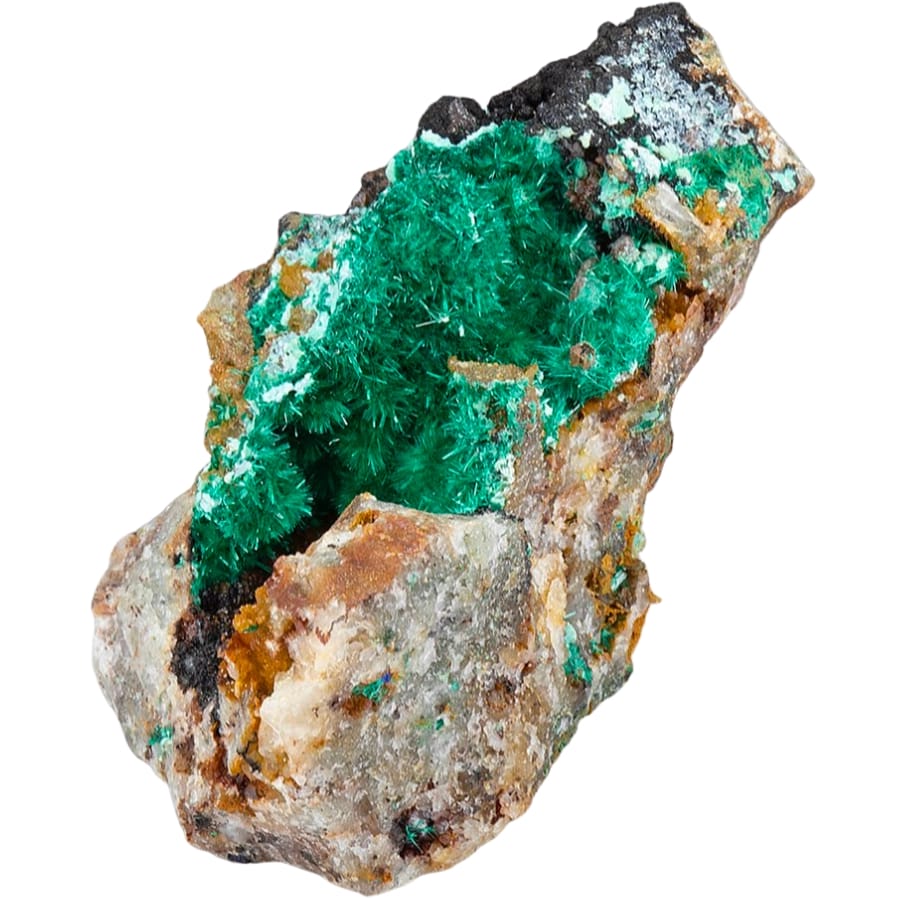
Known for its beautiful, deep green color, brochantite often forms in places where copper is found. That is because it’s made of copper, sulfur, and oxygen.
It usually forms in dry, arid regions where copper minerals react with the oxygen in the air and the sulfur in the water.
Because of this, brochantite is often found in the upper zones of copper deposits. These are areas where copper is close to the surface and gets exposed to air and water. This mineral can form in various shapes, from tiny needle-like crystals to larger, more complex structures.
Brochantite’s vivid green color makes it a favorite among mineral collectors and enthusiasts. It’s also important for scientists and geologists because it tells them a lot about the environment where it formed, like the amount of water or oxygen there.
Additionally, because brochantite contains copper, it can be a useful indicator of larger copper deposits nearby.
Where you can find brochantite in Utah
The sole site where you can find brochantite in Utah is at the Yellow Canary Uranium Deposit, which is on the west side of the Red Creek Canyon.
Orpiment
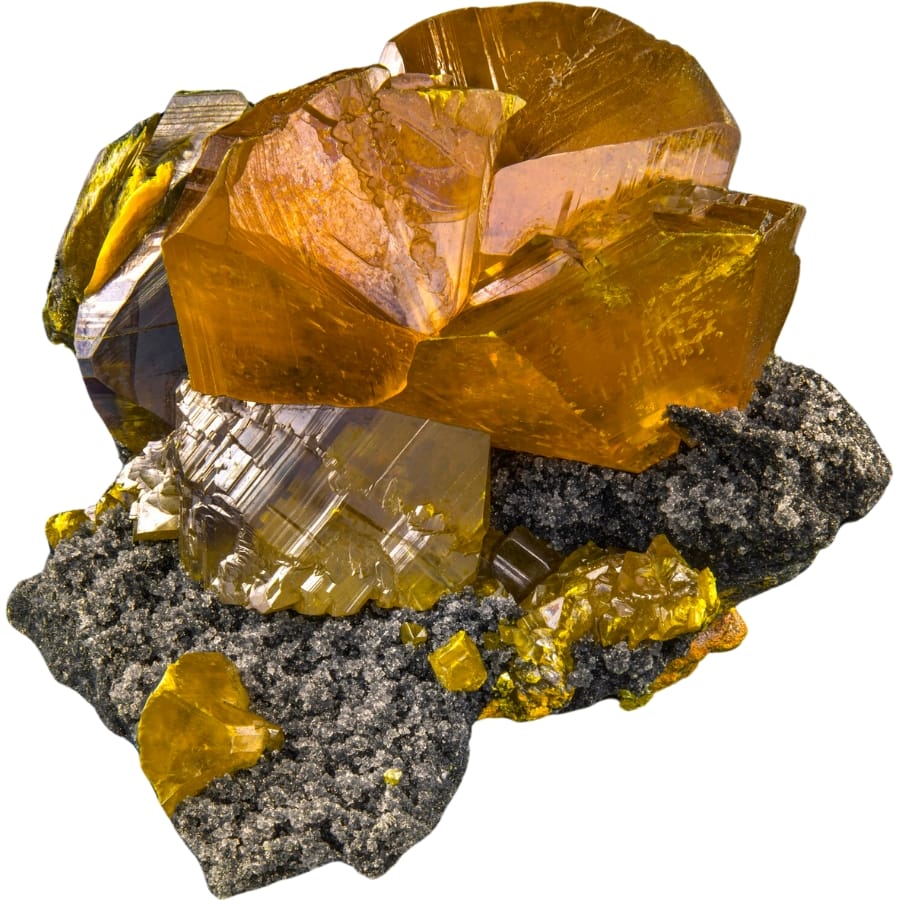
Orpiment catches your eye with its bright yellow to orange color. It’s made up of arsenic and sulfur, which might sound scary because arsenic can be dangerous, but in orpiment, it’s locked up in it.
This mineral is usually found in volcanic areas or hot springs. That’s because it forms from the cooling of volcanic gases or from waters heated by volcanic activity deep underground. When these gases or waters come up to the surface and cool down, they leave behind orpiment.
We have been interested in orpiment for a long time, but not just because it’s pretty. In ancient times, it was ground up and used as a paint or dye. Its bright yellow color was really popular for decorating things.
Nowadays, we know to be careful with it because of the arsenic, but scientists and collectors still find it fascinating.
Orpiment is also valuable to scientists because it can tell them about the conditions deep underground where it formed. By studying it, they can learn about the temperature and pressure deep in the Earth, and even about the kinds of gases that were present in volcanic areas long ago.
Where you can find orpiment in Utah
To find orpiment, you can search through the following areas:
- Mines in San Rafael district
- Mines in Mercur
- Vipont Mine
The Gemstones Found In Utah
You might get dizzy with the vast variety of gemstones found in Utah. If you want to explore our state for them, here are some helpful guides that we created:
Topaz
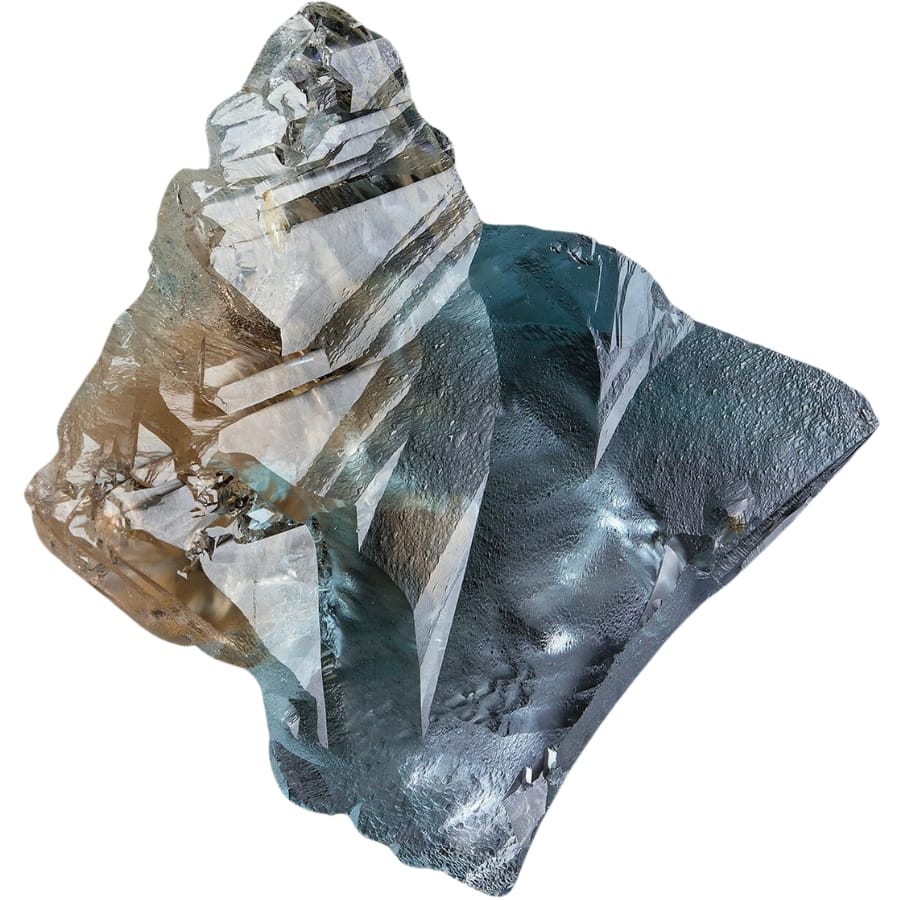
Topaz can be found in lots of different colors, from clear and colorless to blue, pink, and even golden yellow. Its most common color, though, is a beautiful sky blue.
This gem is made of a mineral that forms deep under high pressure. It forms in cracks or cavities in rocks where the right mix of minerals and fluids come together.
The Utah topaz is famous for being really clear and sometimes a shimmery, golden color. Over time, it can even change color. When it’s first dug up, it might be clear or have a light color, but if you leave it in the sun, it can turn pink!
The value of topaz is influenced by it being just plain beautiful. The way it sparkles and comes in so many colors makes it a favorite for jewelry.
Also, it’s pretty hard, which means it doesn’t scratch easily. That’s great for rings or necklaces that you might wear every day.
Where you can find topaz in Utah
Lucky for you, topaz is abundant in Utah. Below are some only of the many places that you can explore for this beautiful gem:
- Dugway Range
- Thomas Range
- Topaz Dome Quarry
Opal
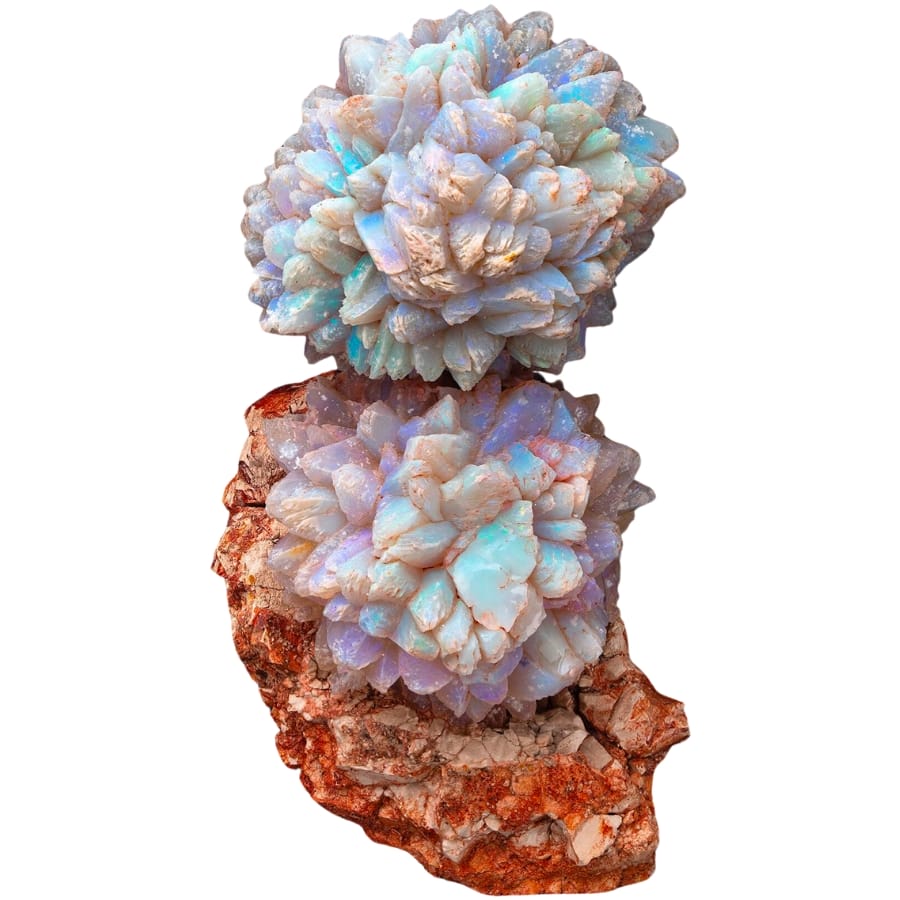
Opal is a dazzling gemstone that looks like it’s filled with rainbows. Itvcan flash all sorts of colors like blue, green, pink, and even gold. This happens because of tiny bits of water trapped inside it, which scatter light into all these colors.
Opals are made from a mineral called silica, which is also in sand. It got mixed with water and settled into tiny layers. Opal usually develop in cracks and spaces in other rocks, like limestone or sandstone.
Over a long time, water carrying silica seeps into these cracks. When the water evaporates, it leaves the silica behind, and layer after layer, the opal starts to form.
Opals are valued for their stunning colors and patterns. Each one is unique, kind of like a fingerprint, and that makes them really special. They’re often used in jewelry to show off their beauty.
Opals are also the birthstone for October, so they’re extra special for those born in that month.
Where you can find opal in Utah
Below are some of the locations where you can find opal in our state:
- Area mines in Frisco
- Fish Lake
- Colorado River
Agate
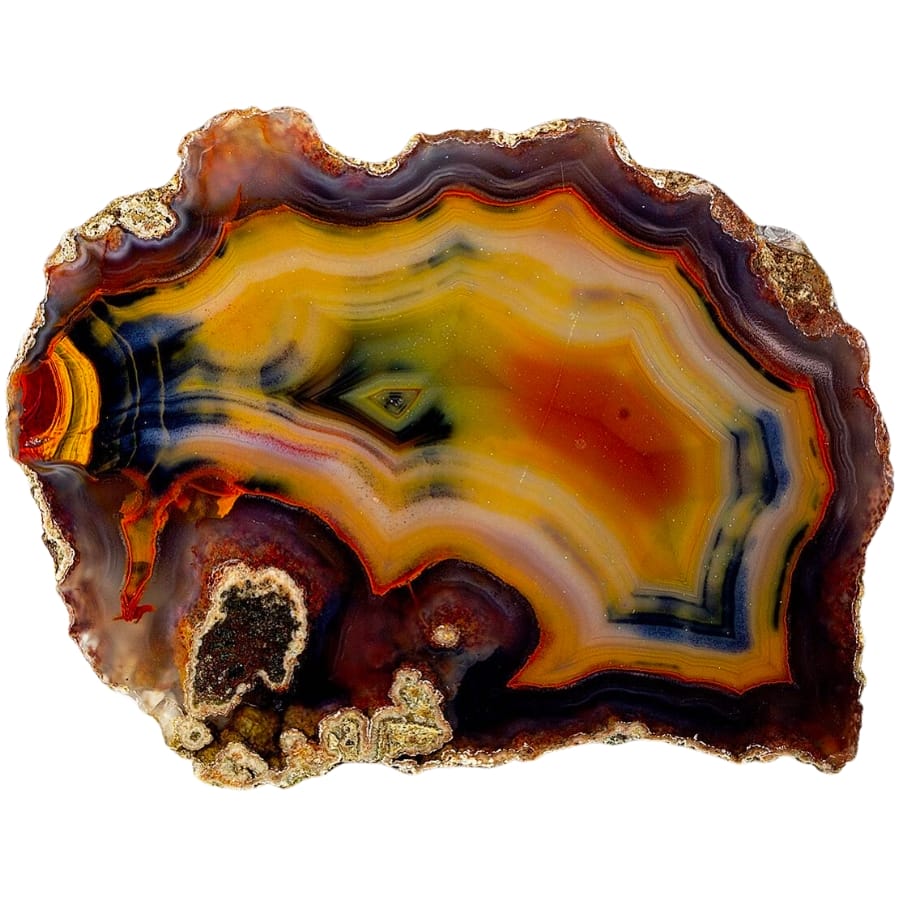
Agate is part of the quartz family that’s famous for its beautiful stripes or bands of different colors. These colors can be all sorts of shades like red, blue, brown, and white. Sometimes, it can even have patterns that look like pictures or landscapes!
This gem form in a cool way, usually starting out in spaces within rocks, like holes in lava or bubbles in volcanic rocks. Over a long time, water with silica in it seeps into these holes.
The silica gets left behind, layer by layer, as the water evaporates. This process creates bands or stripes, which influences the overall value of agate.
This gem has been loved for a long time because they’re so pretty and unique. Each agate is different, with its own pattern of colors and bands.
They’re often cut and polished to make jewelry, because they’re not only beautiful but also quite hard and durable.
Where you can find agate in Utah
You can find agate in many places within our state. These are some of them:
- Agate area
- Circle Cliffs
- Beaver Dam Wash
Jasper
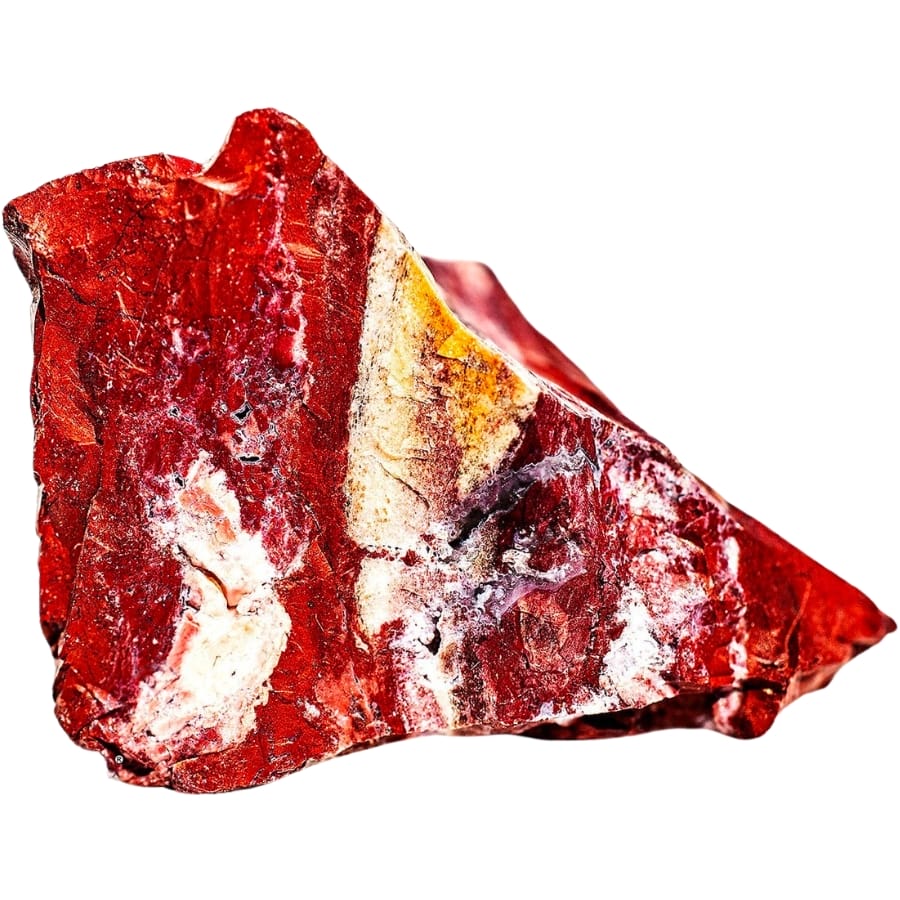
Like agate, jasper is also part of the quartz family. It has a smooth surface and a wide range of colors. You can find it in reds, yellows, browns, and even greens. Sometimes, it has patterns like stripes, spots, or swirls, too.
Jasper forms from volcanic ash or sediment. Over a long time, this ash or sediment gets mixed with silica and then gets squished and heated. This heat and pressure change it into jasper.
Jasper’s value is influenced by many factors. It’s not just pretty, but also strong and easy to carve. In ancient times, people made tools, seals, and even jewelry out of this gem.
Today, jasper is still popular for jewelry like necklaces and bracelets because it’s so durable and comes in so many different looks.
Where you can find jasper in Utah
Among the different areas where you can find jasper in Utaha are:
- Hanskville
- San Rafael River
- Sweet Water Canyon
Garnet
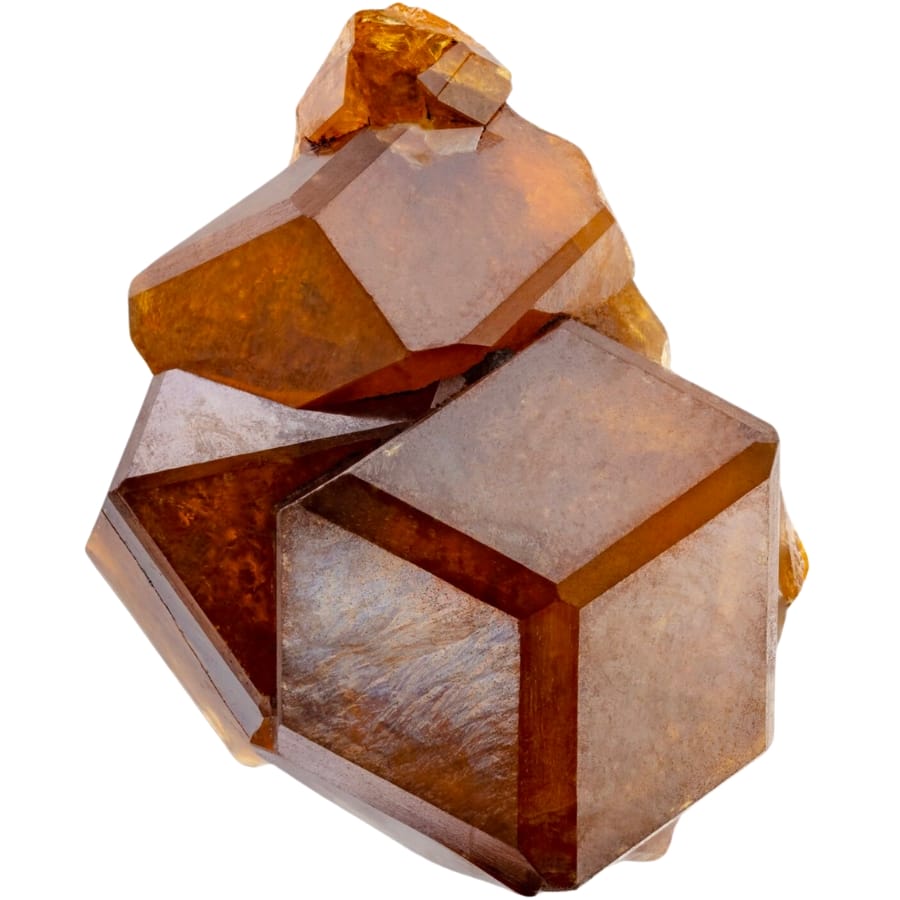
Garnet is known for its deep red color, although it can come in other colors too, like green, orange, or even purple. It’s actually a group of minerals that form under a variety of conditions.
Most garnets form when rocks deep underground are heated and squished under a lot of pressure. This can happen during processes like mountain building or when two of Earth’s tectonic plates smash together.
It can also form from rocks that are heated up by magma underground. Sometimes, this gem is found in rocks that have been altered by hot fluids from deep.
Garnet’s value has been evident for a long time because of its beautiful colors and how it sparkles in the light. It’s quite hard and durable, too, making it great for jewelry that you can wear every day.
Also, because garnet can handle high temperatures and isn’t easily scratched, it’s useful in industrial settings, like for cutting materials.
Where you can find garnet in Utah
If you want to uncover garnet here, you can visit and search through the following sites:
- Amasa Valley
- Painter Spring
- House Range
Cerussite
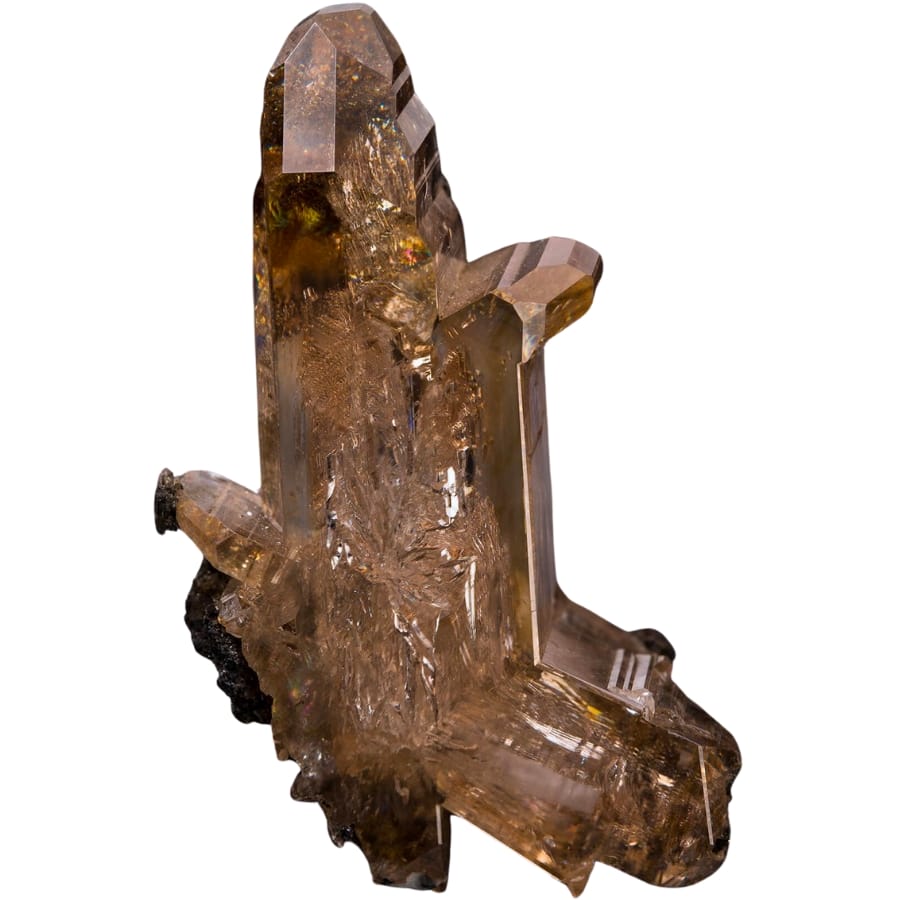
Known for its sparkly, diamond-like appearance, cerussite can be clear, white, or even have a hint of gray or blue. This gem is actually a form of lead carbonate.
It forms usually in areas where lead ores are found. When lead combines with carbon and oxygen, often in the upper parts of lead ore deposits where the lead gets exposed to air and reacts with it, cerussite is created.
This amazing gem has a high level of sparkle, technically called “dispersion.” It’s a measure of how much a gem can split light into different colors, like a tiny rainbow.
Cerussite has a dispersion higher than diamond, which means it’s super sparkly and catches the light in a dazzling way. This makes it really popular for collectors and gem enthusiasts.
This gem is also valuable to scientists and geologists. By studying cerussite, they can learn about the levels of lead and oxygen in the area where it formed and how different minerals react with each other.
Where you can find cerussite in Utah
Our state has an abundant deposit of cerussite, and some of the best places to explore for it are:
- Bradshaw Mountains
- Wah Wah Mountains
- Bullion Canyon
The Crystals Found In Utah
Like its abundant rocks, minerals, and gems, Utah’s crystals are also a sight to behold. If you want to know where to find them, make sure to check out this guide:
Amethyst
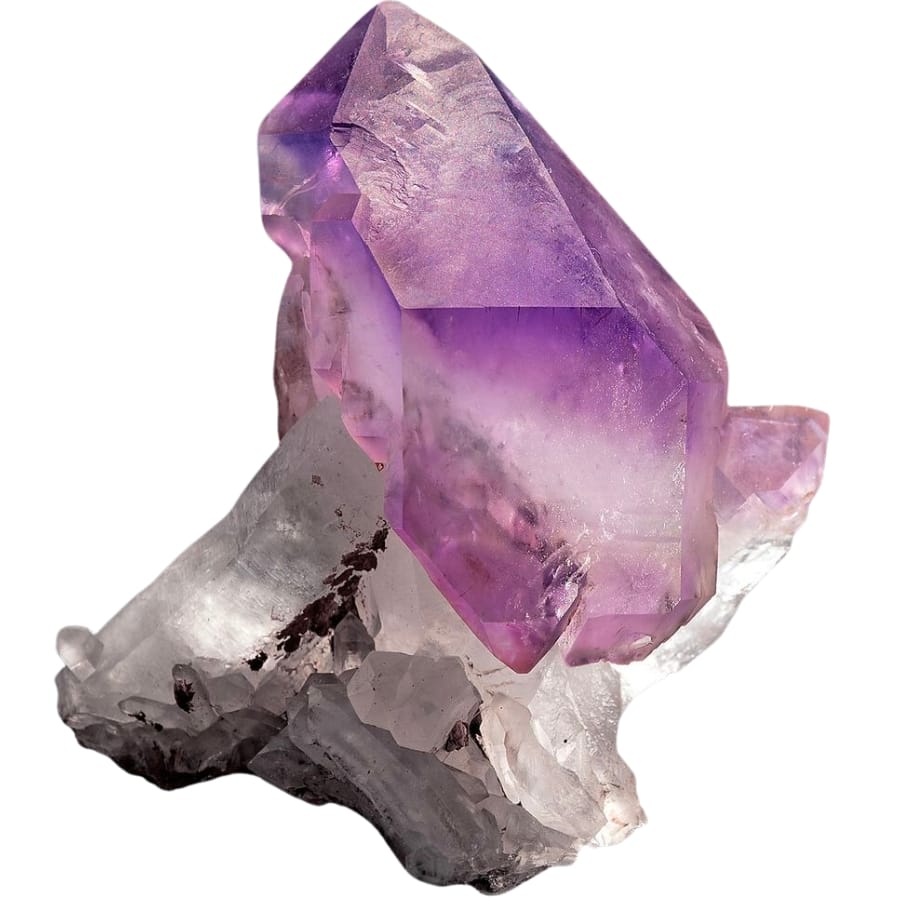
Amethyst is a beautiful purple crystal and a type of quartz. The purple color, ranging from a light lavender to a deep purple, is what makes it really special.
The reason amethyst is purple is because of tiny amounts of iron inside the quartz. When the it’s heated up deep in the Earth, this iron gives the amethyst its lovely purple color.
Amethyst usually grows in hollow rocks called geodes that form when lava cools and hardens. Inside it are little pockets where water with minerals can get in. Over a long time, this mineral-rich water deposits quartz inside the geode, and some of this quartz turns into amethyst.
The worth of amethyst has been appreciated for thousands of years. In the past, it was considered a precious stone, just like diamonds or rubies.
Today, it’s loved for its beauty and the way it sparkles in the light. Amethyst is often used in jewelry, like necklaces and rings. It’s also the birthstone for February, which means its special for those born in that month.
Where you can find amethyst in Utah
Amethyst deposits are widespread in our state, and some of the places where you can search for them are:
- La Sal Mountains
- Dugway mining district
- San Rafael Swell
Fluorite
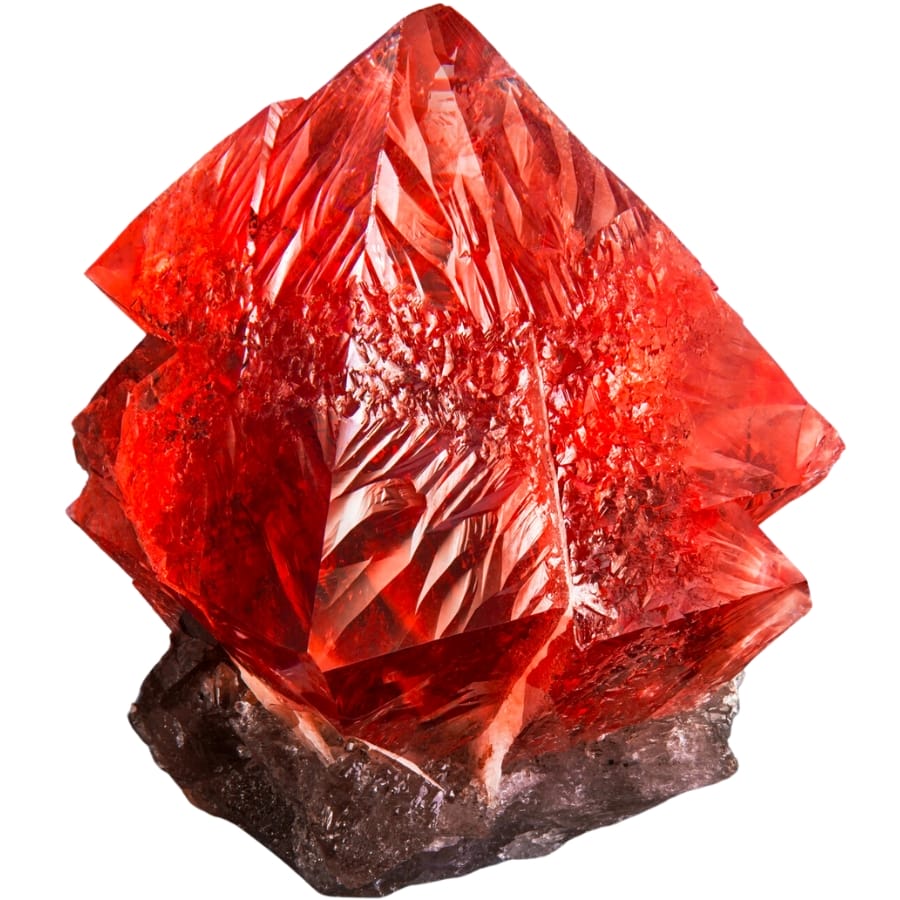
Fluorite is a crystal that’s known for its amazing range of colors. It can be purple, blue, green, yellow, or even clear. Sometimes, one piece of fluorite can have several colors in it, which looks super pretty.
This crystal is made up of calcium and fluorine. It usually grows in veins in rocks, which are like tiny highways for hot water deep underground. This hot water has lots of minerals dissolved in it.
When the water cools down, the minerals start to come out of the water and form crystals. That’s how fluorite is made. The different colors happen because of tiny amounts of other minerals in the crystal.
How much fluorite is worth is rooted not only in its beauty but also its uses. It’s used in making things like steel and aluminum. It’s also used in making lenses for telescopes and cameras because it lets light pass through it very clearly.
Fluorite is popular with collectors because of its colors and because it often forms in cool shapes like cubes or octahedrons (eight-sided shapes). Plus, under ultraviolet light, some fluorite even glows!
Where you can find fluorite in Utah
Here are some of the many places where you can find fluorite in our state:
- Deep Creek Mountains mine
- Desert Mountain mines
- Fish Springs mines
Pyrite
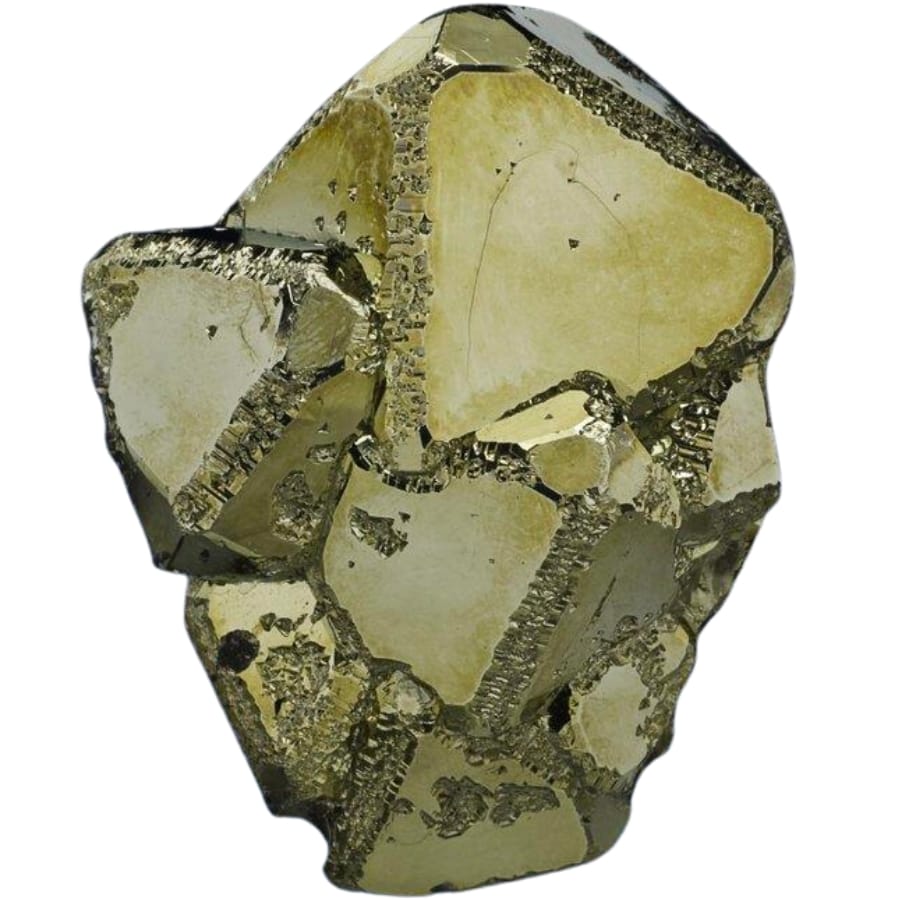
Often called “fool’s gold,” pyrite is a shiny, metallic-looking crystal that gets people excited because it looks like real gold. But it’s actually not gold at all!
It’s made from iron and sulfur and usually forms in squares or cubes, which is pretty neat because most crystals don’t have that shape.
Pyrite forms in different ways. One common way is when tiny particles of iron and sulfur mix together in water. This mixture sinks to the bottom and starts to form crystals.
Pyrite can also form in rocks that are heated up by magma from volcanoes. The heat makes the iron and sulfur come together and grow into its crystals.
Though it looks like gold, the price of pyrite is far from it. And although it has gained interest because of its resemblance to gold, it’s not just its looks that make pyrite valuable. It’s used in making sulfuric acid, which is an important chemical in lots of industries. It’s also used to make iron.
Where you can find pyrite in Utah
To locate pyrites, below are some of the spots you can explore:
- Tintic Prince Mine
- Spor Mountain
- Little Drum Mountains
Azurite
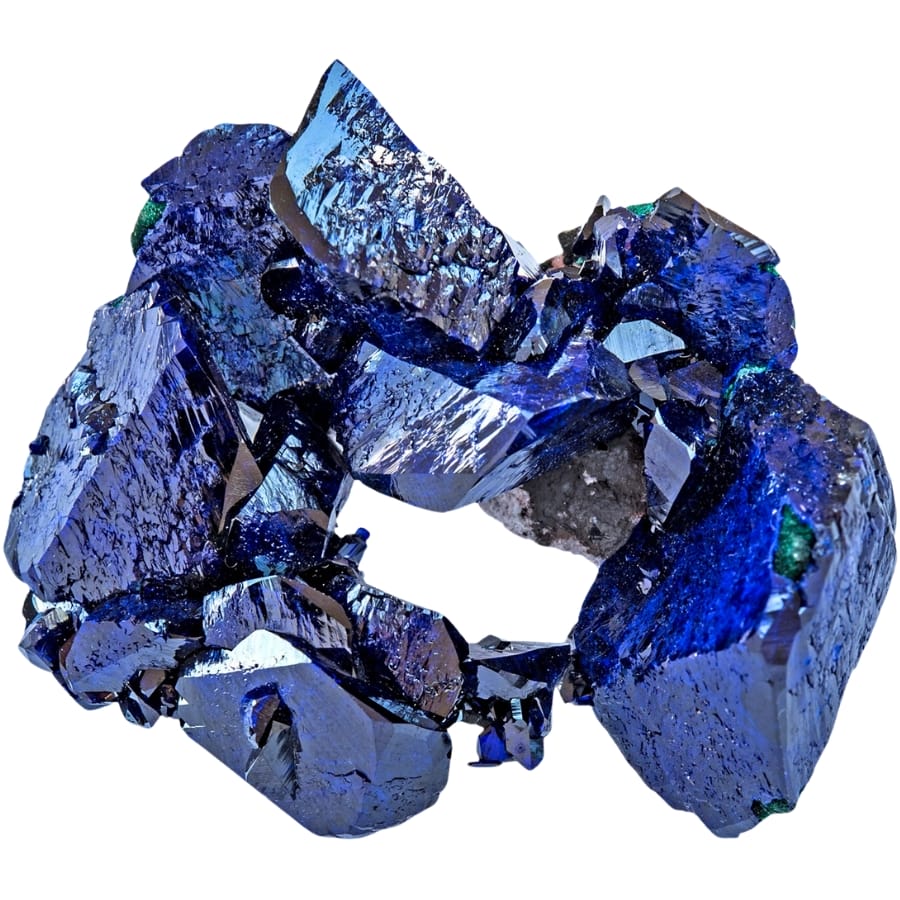
Azurite is a stunning crystal that’s famous for its deep, vibrant blue color. It’s actually a copper mineral, which means it’s made from the same stuff as pennies and pipes, but in a different form.
It usually forms in places where copper-rich rocks are exposed to air and water. This happens a lot in desert regions where copper mines are.
When water seeps into copper-rich rocks, it starts a chemical reaction. This reaction changes the copper and other minerals in the rocks into azurite. Over time, as more and more of these reactions happen, the azurite crystals start to grow.
Sometimes, this crystal is found with another blue-green mineral called malachite, which we’ll talk about more below.
The deep blue color of azurite has made it popular for jewelry and decoration for thousands of years. Artists used to grind it up to make a blue pigment for paint. This paint was used in some of the most famous artworks in history.
Where you can find azurite in Utah
We highly recommend exploring the following places if you want to find azurite:
- Willard area mines
- Little Bear River
- Swan Creek
Malachite
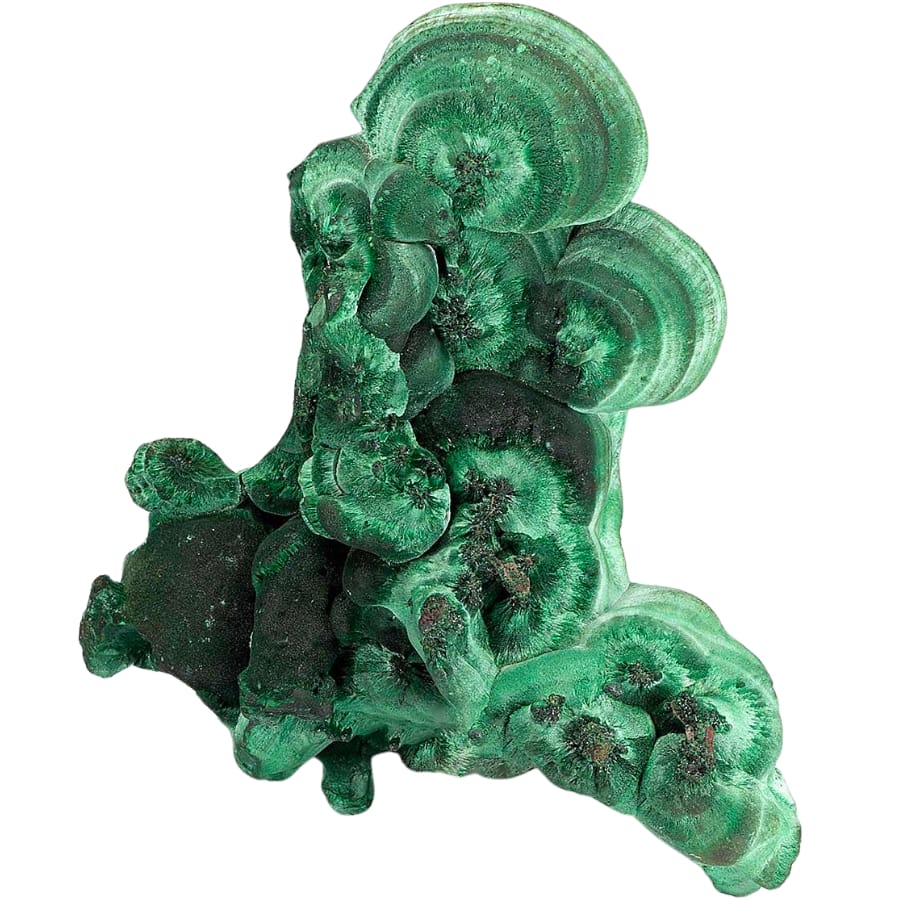
Malachite stands out because of its bright green color. It’s made from copper but it looks totally different.
When water with copper in it moves through rocks, it reacts with other minerals and oxygen in the air. This reaction changes the copper and minerals into malachite.
One of the most amazing things about this crystal is its patterns. It often has stripes or bands of different shades of green, which can look like waves or swirls. And as we said, you can often find malachite mixed with azurite.
Malachite’s value is tied to its beauty and uses. In ancient times, people used it to make jewelry and decorations because it’s pretty and easy to carve.
It has also been ground up to make green paint. Even today, it’s popular in jewelry and for decorative objects like bowls or sculptures.
Where you can find malachite in Utah
You can find beautiful specimens of malachite if you search through the following:
- Promontory Mountains
- La Plata area
- Farmington mining district
Quartz

Quartz is a super common but really amazing crystal that you can find all over the world. It’s known for being clear and shiny, but it can also come in different colors like pink (rose quartz).
It’s made of silicon and oxygen, two of the most common elements in the Earth’s crust. It usually starts forming deep underground, where it’s really hot. When minerals in the rocks mix with water, they dissolve.
As this mineral-rich water moves through cracks in the rocks and cools down, quartz starts to form. Sometimes, the water evaporates and leaves this crystal behind.
The value of quartz depends on many factors, including its appearance and usefulness. In ancient times, people made tools and even crystal balls out of quartz.
Today, we use this crystal in watches and clocks because it helps keep time accurately. Quartz is also used in electronics and for making glass.
Where you can find quartz in Utah
Quartz is abundant and widespread in Utah, and some of the speficic areas where you can find them are:
- Little Cottonwood
- Wells Canyon
- Bullion Canyon
The Most Valuable Rocks and Minerals in Utah
Now that we’ve gone through the common rocks, gems, and crystals of our state, let’s head on to the exciting part: the valuable rocks in Utah.
Just a disclaimer, though, that “value” is not necessarily about its price, but more about how special they are as natural finds.
Sunstone
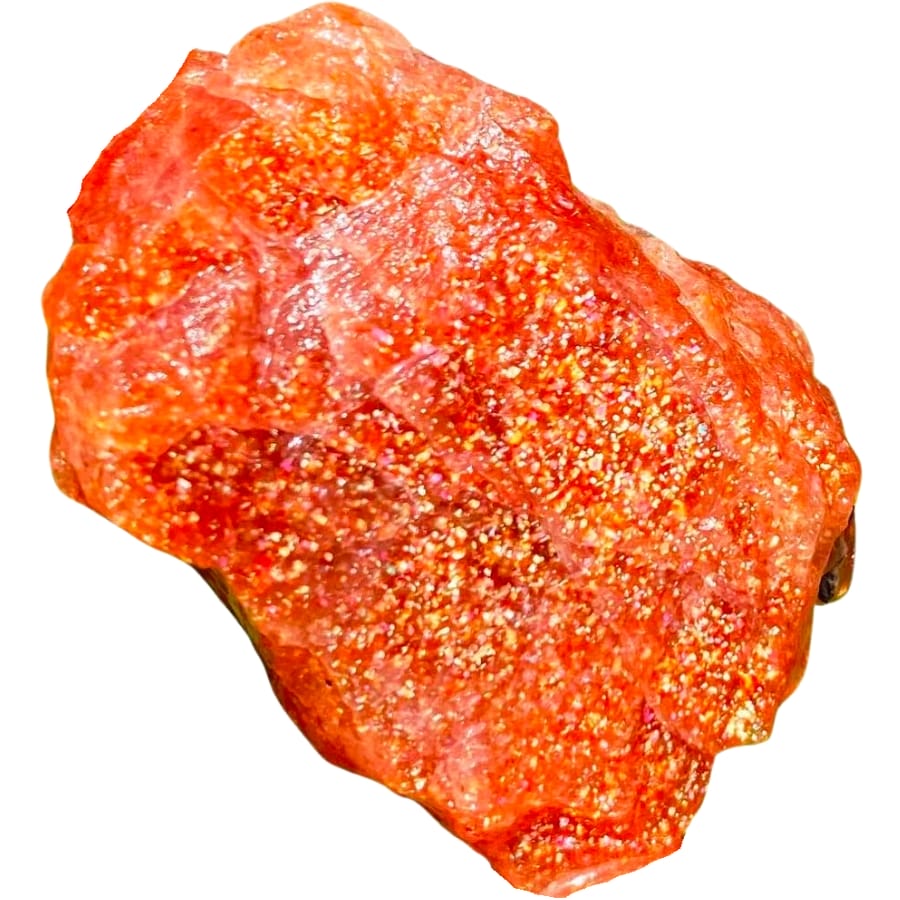
Sunstone gets its name from its sun-like shine and sparkle. This special sparkle is because of tiny pieces of minerals inside it, like copper or hematite, which reflect light in a flashy way.
It’s formed from molten rock, like lava. When lava cools down and turns into rock, the sunstone starts to form. The cooling process allows crystals to grow within the rock. The slower the lava cools, the bigger the sunstone crystals can get.
Among the reasons we value sunstone is its unique glittery look. It can be orange, red, pink, or even green, and it’s often used in jewelry. The way it catches the light makes it really eye-catching and beautiful.
Where you can find sunstone in Utah
There is only one known location where you can find sunstone in Utah, and it’s named aptly as the Sunstone Knoll.
Geode
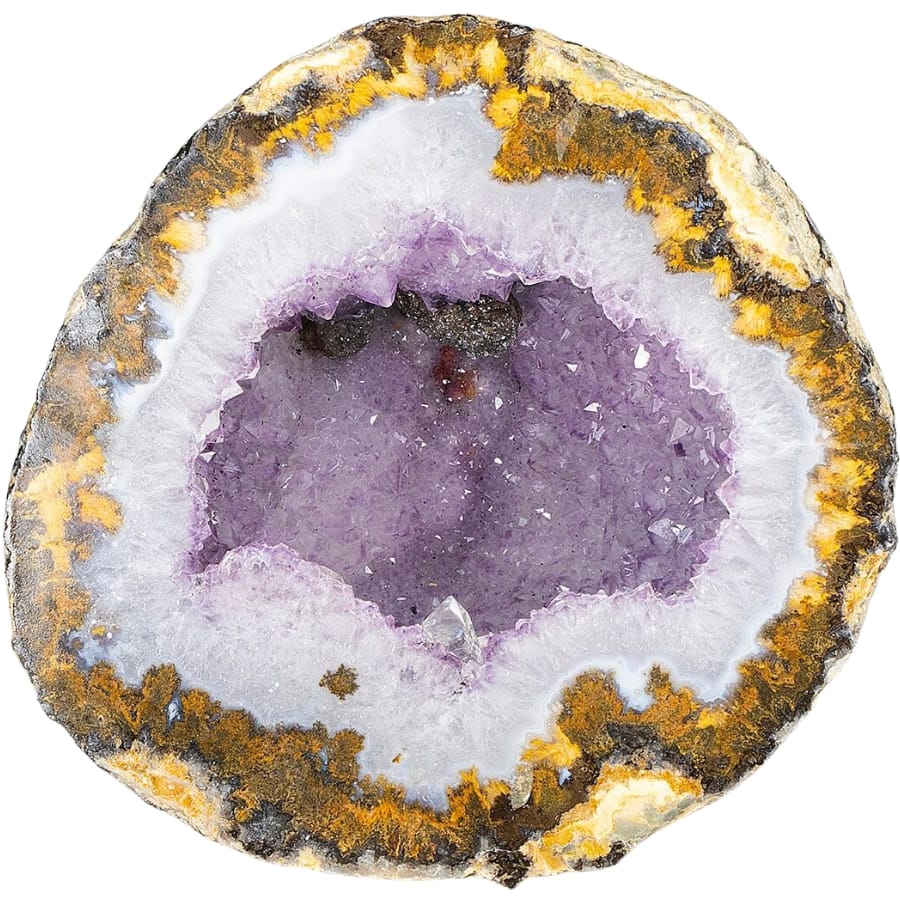
A geode looks plain on the outside but it has a hidden surprise inside. When you crack it open, you’ll find it’s lined with crystals!
Geodes start as bubbles in volcanic rock or as animal burrows, tree roots, or mud balls in sedimentary rock. Over time, these holes get filled with water rich in minerals. When the water evaporates, it leaves the minerals behind.
These minerals start to form crystals over a long, long time. The type of crystals depends on what minerals are in the water. It could be quartz, amethyst, or even different kinds of sparkling gems.
Because each one is a mystery until you open it, geode’s value can vary. You never know what colors or kinds of crystals are inside. They’re super popular with rock collectors and nature lovers.
Where you can find geode in Utah
You’re lucky because our state is quite rich in geodes, and some of the areas that you can explore for them are:
- Dugway Geode Beds
- Simpson Springs
- Newcastle washes and draws
Gold

Gold has been valued by people for thousands of years, so no wonder it made our list of valuable rocks in Utah. It doesn’t rust or tarnish, which means it stays shiny forever.
Gold is pretty rare, and it’s formed deep under high pressure and heat. It’s usually found mixed in with quartz rocks or in rivers where it’s been washed down from hills or mountains.
This mineral is formed in two main ways. In one way, it’s squeezed up along with lava during volcanic eruptions. When the lava cools, the gold is left in the rock. In the other way, gold is carried by water in small particles. It gets into rivers and settles at the bottom because it’s heavy. Over time, it builds up and forms nuggets or flakes.
Since it’s beautiful and shiny, gold is great for jewelry like necklaces, rings, and bracelets. It’s also really soft and easy to shape, so artists and jewelers love working with it. Plus, gold doesn’t react with air or water, so it doesn’t corrode or tarnish.
Gold is also important in technology. It’s used in computers and phones because it’s a great conductor of electricity and doesn’t corrode.
Where you can find gold in Utah
Despite being very valuable, you might be surprised to know that there are actually many places in our state where you can find gold. Below are some of them:
- Colorado River
- San Juan River
- Raft River Mountains
How to Identify The Rocks and Minerals You Find
Aside from the rocks, gemstones, and crystals that we’ve discussed here, Utah still has other equally-stunning natural treasures. In this section, we’ll teach you simple and doable tips that you can try to identify what you will find.
Observe its physical properties
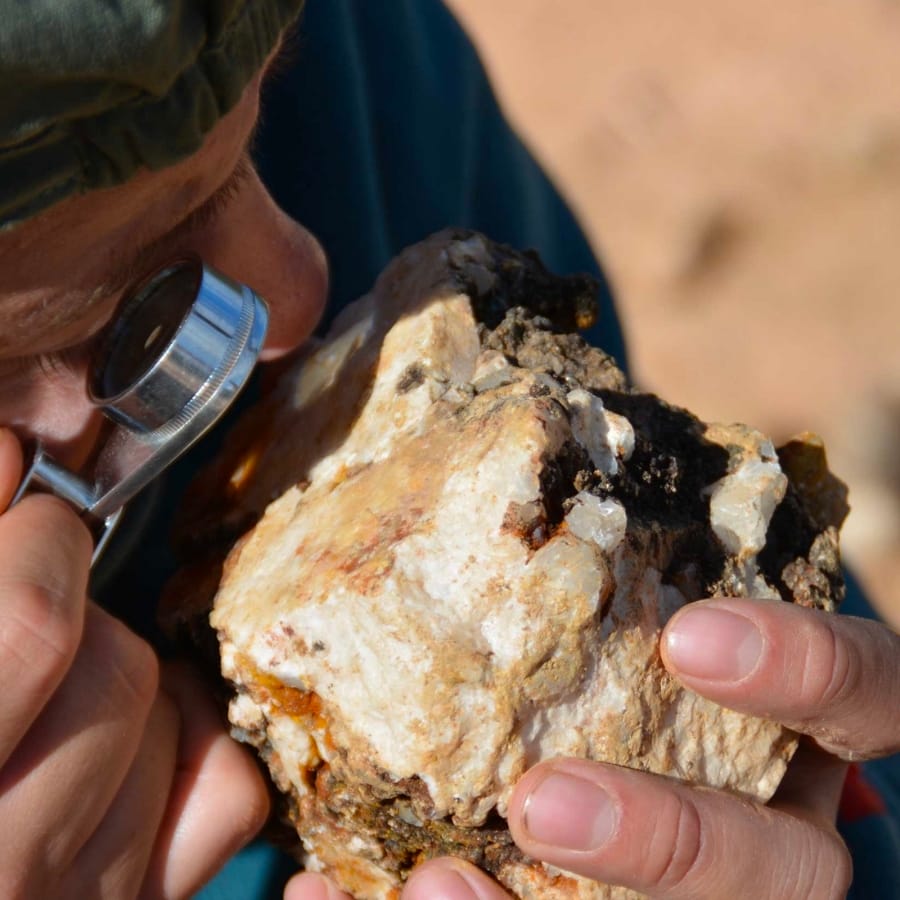
Look at the mineral’s color, luster (how it reflects light), and crystal shape. Some minerals have very distinctive colors or shapes that make them easy to identify.
However, remember that color alone can be deceptive, as some minerals come in a variety of colors. Luster can be metallic, glassy, or dull, and crystal shapes can vary widely, offering important clues to the mineral’s identity.
Test its hardness
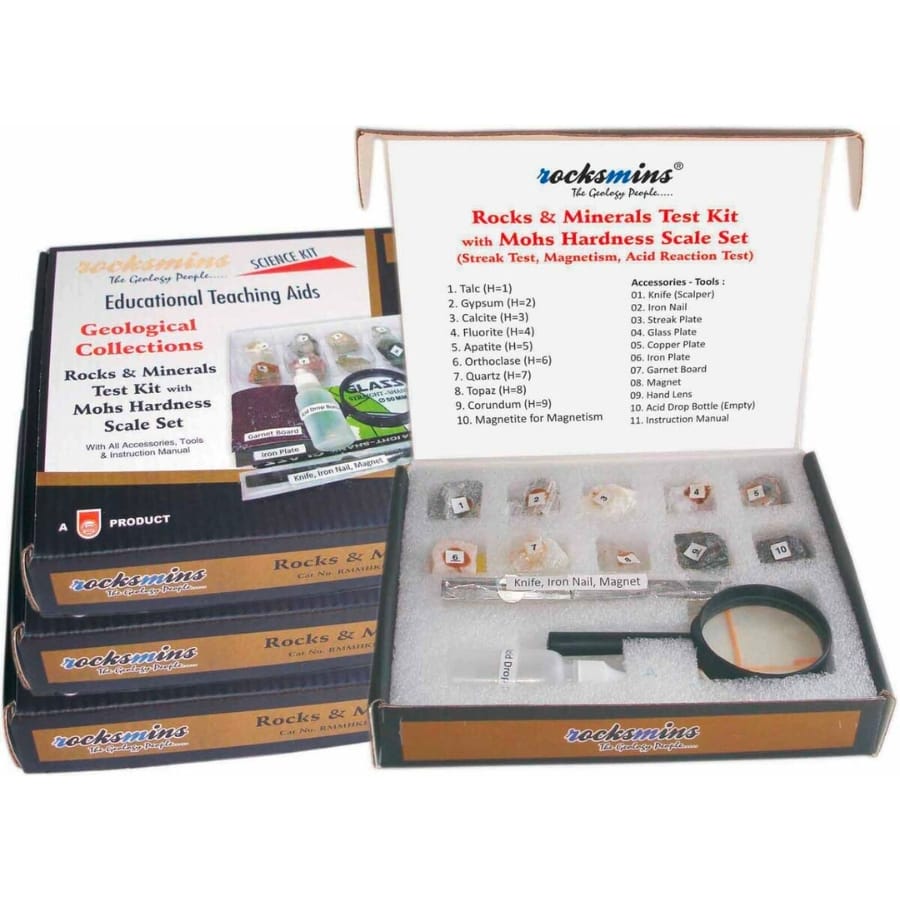
One of the easiest ways to identify a mineral is to test its hardness. The Mohs Scale of Hardness ranks minerals from 1 (softest) to 10 (hardest).
You can test the hardness by seeing if the mineral can scratch a common object like a fingernail (hardness 2.5), a copper penny (3.5), or a glass window (5.5).
For example, if a mineral can scratch glass but not a penny, its hardness is between 3.5 and 5.5.
Do a streak test
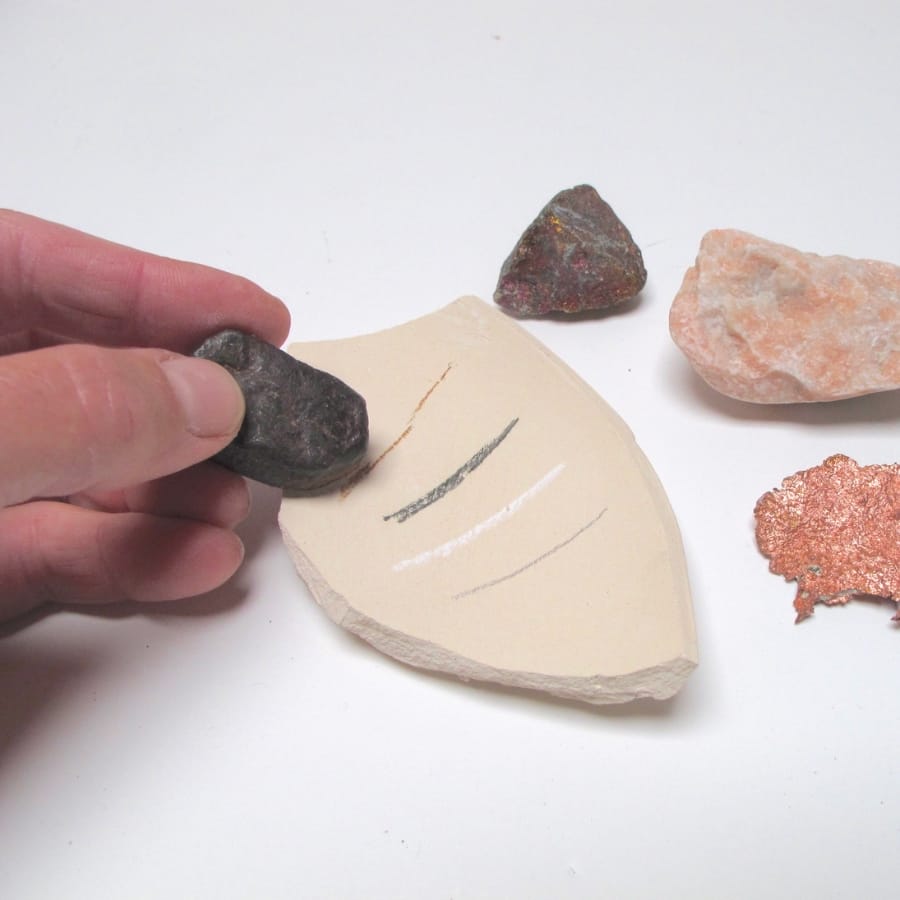
The streak test involves rubbing the mineral across an unglazed porcelain tile, known as a streak plate. The color of the streak it leaves behind can help you identify it.
This works best for minerals that are softer than the streak plate. It’s important to note that the streak color can be different from the color of the mineral itself.
Check if it’s magnetic
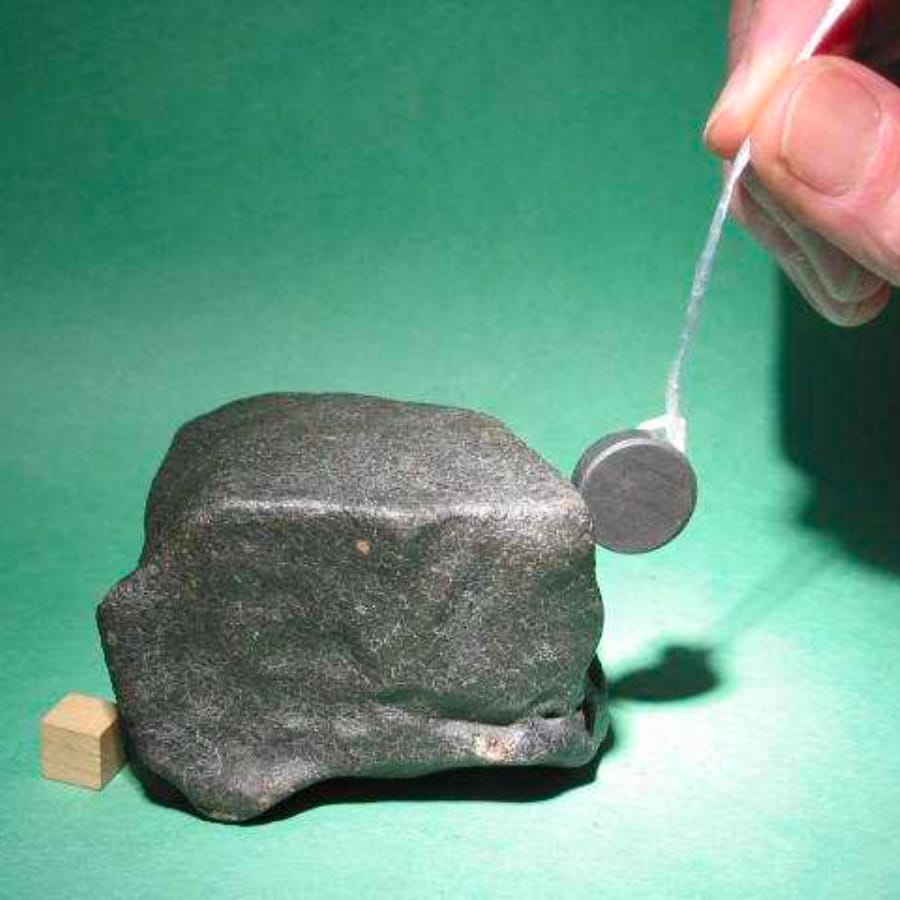
Some minerals, like magnetite, are magnetic. You can test for magnetism by seeing if the mineral is attracted to a magnet.
This is a simple but effective way to identify magnetic minerals. Just pass a strong magnet over the mineral and observe if there’s any attraction.
Try an acid test
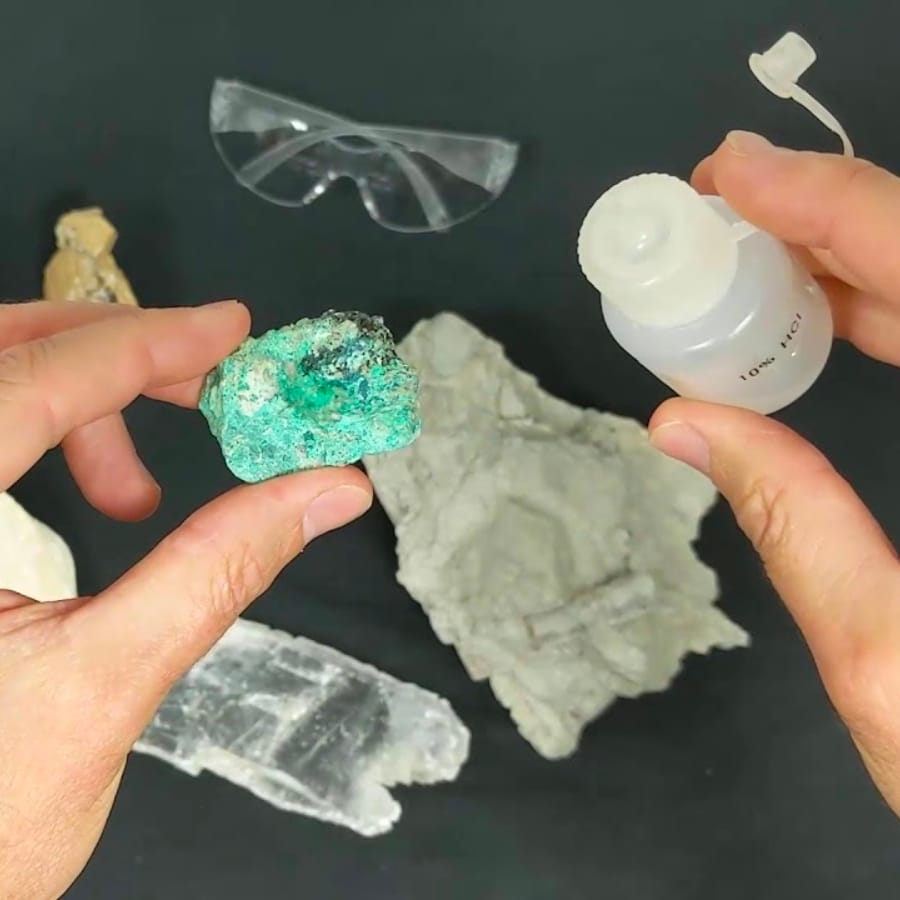
This test helps identify minerals containing calcium carbonate, like limestone and marble. You can use vinegar or a diluted hydrochloric acid solution.
If the mineral fizzes or bubbles when the acid touches it, it likely contains calcium carbonate. Be sure to use safety precautions like gloves and eye protection when handling acids.

